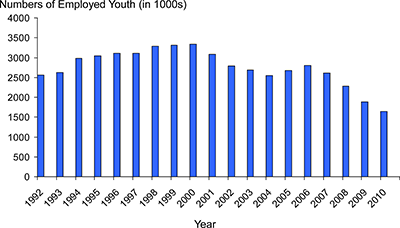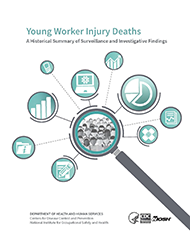Young workers have high rates of job-related injury. These injuries are often the result of the many hazards present in the places they typically work, such as restaurants, warehouses or in construction.
Limited or no prior work experience and a lack of safety training also contribute to high injury rates. Middle and high school workers may be at increased risk for injury since they may not have the strength or cognitive ability needed to perform certain job duties.

Fast Stats:
- In 2016, there were about 19.3 million workers under the age of 24. These workers represented 13% of the total workforce1.
- In 2015, 403 workers under the age of 24 died from work-related injuries2.
- In 2015, there were 24 deaths to workers under 18 years of age2.
- From 1998-2007, there was an average of 795,000 nonfatal injuries to young workers each year treated in hospital emergency departments3.
- The rate of work-related injuries treated in emergency departments for young workers was almost twice the rate for workers 25 years of age and older3.
To help address this problem, the U.S. Public Health Service developed a Healthy People objective to reduce rates of work-related injuries among workers 15-19 years of age by 10 percent by the year 2020.
- The OSHA HAZWOPER Standard (29 CFR Part 1910.120) – requires that all workers that are exposed to or handle hazardous materials must take a 24hr or 40hr HAZWOPER Training Course and an 8hr Annual Refresher.
- 8hr Refresher: $40 / 24-hour: $155 / 40-hour: $255
- 10% OFF SALE: Enter Promo Code "TRAIN10OFF" at Checkout
Youth Fatality Rate Declining
Both the rate and the number of fatalities among working youth has declined since 2000. NIOSH suggests this may be partially due to a decrease in the number of youth workers, as well as a trend of youth workers in lower risk occupations or industries.

NIOSH Report: Young Worker Injury Deaths
NIOSH has published the 2017 report: Young Worker Injury Deaths: A Historical Summary of Surveillance and Investigative Findings [PDF – 2,706 KB]
 Introduction
Introduction
Youth account for a relatively small, yet important component of the United States (U.S.) workforce. For the 5-year period from 2009 to 2013, a monthly average of 2 million youth aged 15 to 17 years were employed during summer months, and 1.5 million were employed during school months5, with a majority of youth working before they finish high school.4 These youth primarily worked in the services industry, which includes restaurants, and the trade industry, which includes retail establishments.6
Through work experiences, youth learn responsibility, develop social skills, and gain independence; however, youth are at a high risk for work-related injuries due in part to unique physical and psychosocial characteristics. A youth’s body proportion is not equivalent to that of an adult.7 Youth may not be physically able to safely operate certain machinery and equipment at work,8 and employer-supplied personal protective equipment (e.g., safety glasses, gloves, hardhats) may not adequately protect youth due to fit issues.
Further, youth, especially those at the younger end of the spectrum (i.e., less than 16 years), do not have fully developed cognitive control systems9 and are more likely to underestimate the dangers associated with work.10
Summary
The four industries with the highest fatality numbers for working youth from 1994 to 2013 were agriculture production (389 deaths), services (181 deaths), construction (143 deaths) and retail trade (65 deaths), the report says.
Both the rate and the number of fatalities among working youth has declined since 2000. NIOSH suggests this may be partially due to a decrease in the number of youth workers, as well as a trend of youth workers in lower risk occupations or industries.

The overwhelming majority of these fatalities were due to events involving vehicles, NIOSH says, which accounted for 48% of the deaths. According to a separate report published by NIOSH in 2013, younger workers are at a higher risk of dying in a motor vehicle crash at work than adult workers ages 25 or older. From 2003 to 2010, NIOSH says the majority of work-related motor vehicle fatalities among youth workers were in the waste management industry.
Within the construction industry, NIOSH found a correlation between worker age and the number of fatalities. According to the report, 84% of the fatalities in construction were 16- and 17- year-old workers and 16% were age 15 or younger.
NIOSH says the document is intended for use by:
- federal and state agencies—to inform regulatory changes, enforcement strategies, and educational efforts;
- employers and educators—to develop policies and practices, training programs, and outreach and educational products;
- researchers—to guide future research efforts;
- qquipment manufacturers, distributors, and rental companies—to guide outreach and educational efforts.
NIOSH also created a document with information and advice for employers and a document for parents of youth workers.
About NIOSH
The National Institute for Occupational Safety and Health (NIOSH), under the Centers for Disease Control and Prevention (CDC) within the Department of Health and Human Services, is the federal institute responsible for occupational safety and health research. The mission of NIOSH is to generate scientific knowledge and to communicate that knowledge to improve workplace safety and health.
Other Young Worker Safety and Health Resources
- Young Worker Injury Deaths: A Historical Summary of Surveillance and Investigative Findings
- “Getting Hurt is Not in Your Job Description,” a social media campaign by the Massachusetts Department of Youth Employment and Safety Team
- Foundational workplace safety and health competencies for the emerging workforce
- Staying Safe at Work. A curriculum for teaching workers with intellectual and development disabilities (IDDs) about health and safety on the job.
- Youth@Work: Talking Safety. A free, fun, foundational curriculum in workplace safety and health.
- Podcasts – Young People, Obesity and Safety: The Dangerous Links
- Work-Related Motor Vehicle Crashes: Preventing Injuries to Young Drivers: What Parents Should Know
- Work-Related Motor Vehicle Crashes: Preventing Injuries to Young Drivers: What Employers Should Know
- Safe • Skilled • Ready Workforce Program
- Safety Matters. A joint NIOSH/American Industrial Hygiene Association training for young workers
- “Teens at Work: Work-Related Injuries to Teens in Massachusetts, 2007-2011,” a spring 2014 report from the MA Department of Public Health.
- Health and Safety of Young Workers: Proceedings of a U.S. and Canadian Series of Symposia
References
1 NIOSH (2017). Analysis of the Current Population Survey. Morgantown, WV: U.S. Department of Health and Human Services, Centers for Disease Control and Prevention, National Institute for Occupational Safety and Health. Unpublished.
2 Bureau of Labor Statistics (2017). Table A-8. Fatal occupational injuries by event of exposure and age, all United States, 2015.
3 CDC. Occupational Injuries and Deaths Among Younger Workers — United States, 1998-2007. MMWR 2010; 59(15): 449-455.
4 BLS [2005]. Work activity of high school students: data from the National Longitudinal Survey of Youth 1997. Washington DC: U.S. Department of Labor, Bureau of Labor Statistics. http://www.bls.gov/news.release/archives/nlsyth_04272005.pdf
5 NIOSH [2016a]. Analysis of the Current Population Survey. Morgantown, WV: U.S. Department of Health and Human Services, Centers for Disease Control and Prevention, National Institute for Occupational Safety and Health. Unpublished.
6 NIOSH [2016b]. Fatality Assessment and Control Evaluation (FACE) program. Morgantown, WV: U.S. Department of Health and Human Services, Centers for Disease Control and Prevention, National Institute for Occupational Safety and Health, www.cdc.gov/niosh/face/.
7 Bogin B, Varela-Silva MI [2010]. Leg length, body proportions, and health: a review with a note on beauty. Int J Environ Res Public Health 7(3):1047–1075.
8 Chang JH, Fathallah FA, Pickett W, Miller BJ, Marlenga B [2010]. Limitations in fields of vision for simulated young farm tractor operators. Ergonomics 53(6):758–766.
9 Steinberg L [2008]. A social neuroscience perspective on adolescent risk-taking. Dev Rev 28(1):78–106.
10 Vladutiu CJ, Rauscher KJ, Runyan CW, Schulman M, Villaveces A [2010]. Hazardous task recognition among U.S. adolescents working in the retail or service industry. Am J Ind Med 53(7):686–692.
